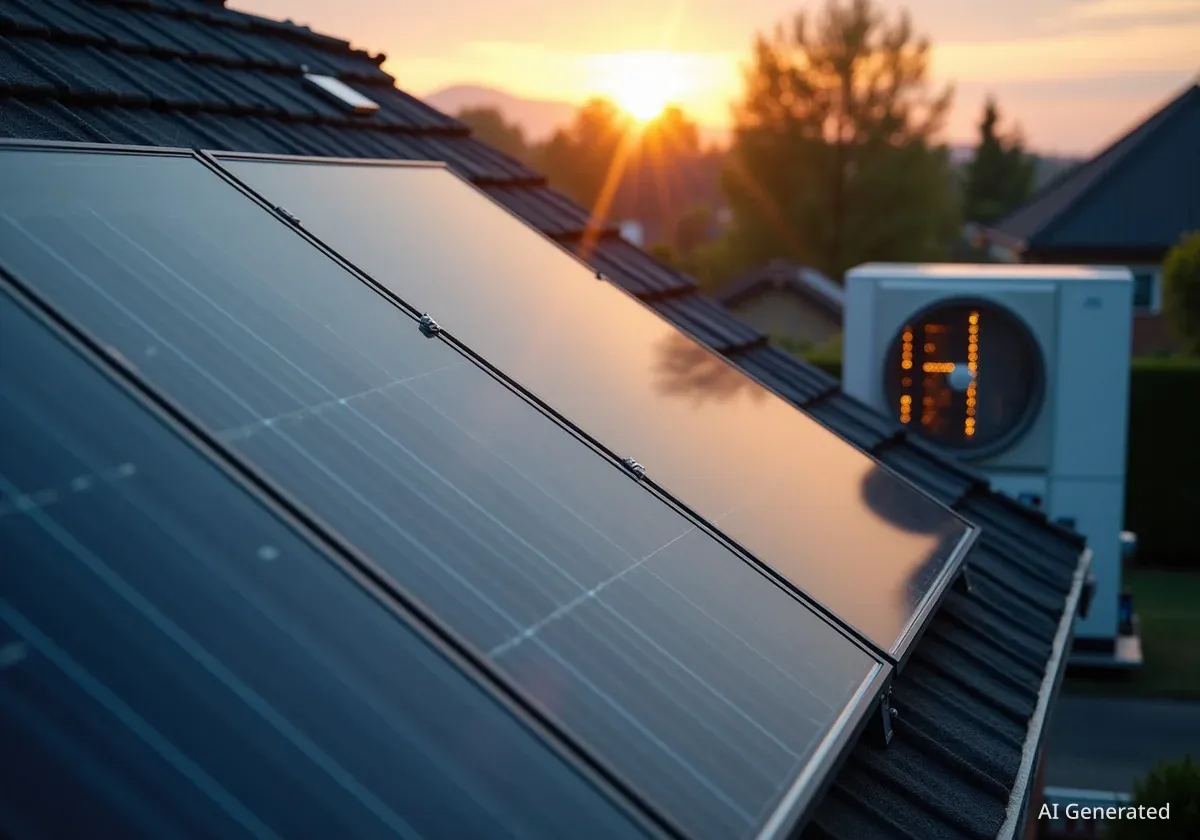A new report from the nonprofit organization Rewiring America suggests that strategic investments in residential energy technologies could completely offset the projected electricity demand from the artificial intelligence industry through 2029. The proposal involves subsidizing home heat pumps, solar panels, and battery storage systems.
Key Takeaways
- A report proposes that tech companies subsidize 50% of home heat pump costs and 30% of solar and battery installation costs.
- This strategy could free up more than 100 gigawatts (GW) of electricity grid capacity by 2029.
- The estimated cost of this residential investment is comparable to building a new fleet of natural gas power plants.
- The plan aims to address the rapidly growing energy needs of AI data centers without relying on new fossil fuel infrastructure.
The Growing Energy Demands of AI
The rapid expansion of artificial intelligence is placing unprecedented strain on the nation's power grid. Data centers, which house the powerful computers needed for AI, are significant consumers of electricity. Utilities and technology companies are actively seeking ways to meet this surge in demand.
According to Rewiring America, the current focus is largely on building large, centralized power sources. These include new natural gas or nuclear power plants. However, these projects often face long development timelines, high construction costs, and in the case of fossil fuels, exposure to volatile energy prices.
Rising Costs for Consumers
In the first half of 2025 alone, U.S. utilities requested approximately $29 billion in rate increases, according to the advocacy group PowerLines. This trend highlights the financial pressure on households even before accounting for new AI-related infrastructure.
A Decentralized Energy Solution
The report from Rewiring America presents an alternative approach centered on residential energy efficiency and generation. Instead of building new power plants, the proposal suggests that the large technology companies driving the AI boom could fund upgrades in American homes.
The core of the plan involves two key subsidies:
- 50% subsidy for heat pump upgrades: This would cover half the cost for homeowners to switch from less efficient heating and cooling systems.
- 30% subsidy for solar and storage: This would cover nearly a third of the cost for installing rooftop solar panels and home battery systems.
By making homes more energy-efficient and capable of generating their own power, this strategy would reduce overall demand on the grid, freeing up capacity for industrial users like data centers. "Hyperscalers are already thinking creatively about how to meet their growing power needs, and this report presents a solution that brings households into the conversation,” said Ari Matusiak, CEO of Rewiring America.
Economic and Grid Advantages
The report argues that this household-focused strategy offers significant economic benefits. The cost to free up over 100 GW of capacity is estimated to be on par with building an equivalent amount of new natural gas generation capacity.
"There’s a way to rebalance the equation and ensure there’s something in it for Americans," Matusiak stated, emphasizing that the status quo of rising utility rates is not sustainable for households.
This approach could also bypass many of the challenges associated with large power plants. According to a recent report from the clean energy group GridLab, the capital costs for combined-cycle gas plants set for deployment around 2030 have increased by nearly 50% compared to those planned for 2026, now exceeding $2,000 per kilowatt (kW).
Furthermore, residential upgrades can be deployed much faster than the typical five-to-six-year lead time required for new gas turbines, providing a more immediate solution to the AI energy crunch.
What Are Heat Pumps?
Heat pumps are highly efficient electrical devices that provide both heating and cooling. They work by moving heat from one place to another rather than generating it through combustion. In the summer, they move heat out of a home, and in the winter, they extract heat from the outside air to warm the interior, even in cold temperatures.
State-Level Impact and Implementation Scale
The potential grid relief could be substantial in states with high concentrations of data centers. The report provides specific examples of how this strategy could work:
- In Georgia, transitioning homes from inefficient electric resistance heating to modern heat pumps could free up an estimated 1.5 GW of capacity. This represents 22% of the state's projected data center load growth through 2029.
- In Texas, replacing conventional air conditioners with more efficient heat pumps could unlock 3.9 GW of capacity, or 23% of the anticipated data center demand over the next five years.
The report acknowledges the ambitious scale of its proposal. To achieve the full 109 GW of capacity from solar and storage, it would require every single-family household in the U.S. to install a home battery, with those having suitable roofs also installing a 5-kW solar system. This projection also depends on a 40% reduction in installation costs through economies of scale and streamlined permitting.
Alignment with Virtual Power Plant Trends
The concept outlined by Rewiring America aligns with the growing interest in Virtual Power Plants (VPPs). VPPs are networks of distributed energy resources, like home batteries and smart thermostats, that can be aggregated to provide power and services to the grid.
A January report from the Department of Energy (DOE) supports the feasibility of such a large-scale deployment. The DOE estimated that VPPs in the United States could reach a capacity of 80 GW to 160 GW by 2030, potentially offsetting 10% to 20% of peak grid demand.
Matusiak noted that several mechanisms could facilitate this vision. These include clean transition tariffs that support distributed resources over new generation, and direct contracts between data centers and companies that aggregate residential energy systems, particularly in competitive markets like Texas.





